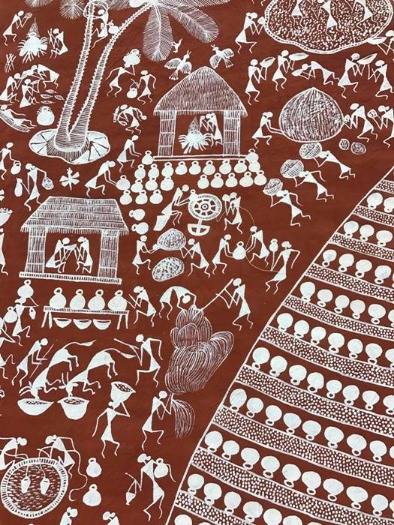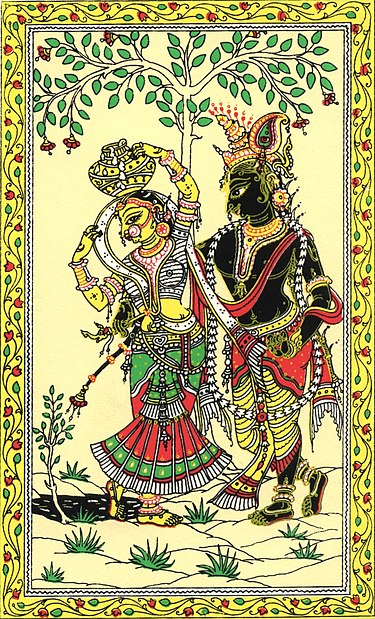Traditional Indian art, steeped in tradition and diversity, boasts a plethora of distinctive techniques that encapsulate centuries of heritage and culture. From the geometric elegance of Warli to the intricate narratives of Madhubani, each art form paints a vivid picture of India’s rich artistic tapestry.

Warli Art: The Elegance of Simplicity
Warli art, originating from the Warli tribe in Maharashtra, stands as a testament to the beauty found in simplicity. Dating back to almost 2500-3000 BCE, this art form is deeply rooted in the daily lives, rituals, and beliefs of the Warli community. Its distinct style, characterized by rudimentary shapes like circles, triangles, and lines, captures the essence of tribal life with captivating charm.
Origins and Themes
The origins of Warli art can be traced to the ritualistic paintings created on the walls of Warli homes during special occasions like weddings, harvest festivals, and births. The motifs primarily revolve around nature, celebrating the harmonious relationship between humans and the environment. Scenes of farming, hunting, dancing, and communal gatherings are recurrent themes, symbolizing unity and the cycle of life.
Technique and Symbolism
The art form employs a minimalistic approach, using basic geometric shapes to create intricate compositions. White rice paste mixed with water and gum is the primary medium, applied on a mud or cow dung-coated surface. The use of a white palette against earthy backgrounds symbolizes fertility, while the geometric patterns signify a cosmic connection, representing the circle of life.
Museums and Preservation
The Warli Art Museum in Thane, Maharashtra, serves as a custodian of this indigenous art form. It houses a rich collection of Warli paintings, showcasing the evolution and versatility of this ancient tradition. These museums not only exhibit the artworks but also serve as educational centers, raising awareness about the cultural significance and preserving the legacy of Warli art for future generations.
Madhubani Art: Narratives in Intricacy
Madhubani art, originating from the Mithila region of Bihar, is a vibrant and intricate art form steeped in cultural heritage. Rooted in mythology, rituals, and daily life, Madhubani paintings are a reflection of the rich Mithila culture and traditions, often celebrated for their elaborate motifs and vibrant colors.
Historical Roots and Cultural Significance
Madhubani art finds its roots in the folk traditions of the Mithila region, where women historically adorned the walls of their homes with these intricate paintings. The art form gained recognition beyond domestic settings in the 1960s when artists started transferring these designs onto paper and canvas, thus bringing this traditional art into the public domain.
Themes and Techniques
Madhubani paintings typically revolve around themes from Hindu mythology, depicting scenes from epics like the Ramayana, Krishna Leela, and other religious narratives. The paintings are characterized by intricate detailing, geometric patterns, and the use of natural pigments. Artists use twigs, brushes, and even fingers to create fine lines and fill vibrant colors derived from natural sources.
Regional Variations and Symbolism
There are various styles within Madhubani art, including Bharni, Katchni, and Tantrik, each with its distinctive features. These styles often differ in terms of intricacy, use of patterns, and the portrayal of themes. Symbolism is prevalent, with elements like lotus symbolizing purity, fish representing fertility, and peacock signifying love and devotion.
Museums and Preservation Efforts
The Madhubani Museum in Madhubani district stands as a testament to the cultural richness of this art form. It houses a remarkable collection of Madhubani paintings, showcasing the evolution and diversity of this traditional art. Museums and cultural institutions play a vital role in preserving these paintings, ensuring their legacy endures.

Pattachitra: The Ancient Scroll Paintings
Pattachitra, originating from Odisha, is a revered art form that manifests as intricate scroll paintings depicting religious stories, folk tales, and mythological narratives. These paintings are crafted with meticulous detailing, vibrant colors, and intricate brushwork, often created on cloth or dried palm leaves.
Origins and Themes
Pattachitra finds its roots in the Jagannath Temple traditions of Odisha, where these scrolls were used to narrate religious stories to devotees. The themes primarily revolve around Hindu deities, legends, and epics like the Mahabharata and Ramayana. Each painting carries a narrative, capturing the essence of ancient tales and cultural ethos.
Technique and Symbolism
Artisans employ natural pigments derived from minerals, plants, and stones to create vibrant hues. The use of fine brushwork and elaborate detailing defines Pattachitra, while geometric precision adds depth to the narratives. These paintings often feature ornate borders, intricate motifs, and depictions of deities and celestial beings.
Museums and Preservation
The Odisha State Museum in Bhubaneswar houses a significant collection of Pattachitra paintings, preserving and showcasing the cultural heritage of this traditional art form. Museums play a pivotal role in ensuring the conservation and dissemination of these artworks to a wider audience, thereby safeguarding their legacy.

Tanjore Painting: Gilded Opulence
Tanjore painting, originating from Tamil Nadu, is renowned for its rich colors, intricate detailing, and opulent use of gold leaf embellishments. This traditional art form, steeped in religious fervor, primarily depicts gods, goddesses, and divine themes, reflecting the cultural heritage of the region.
Historical Roots and Themes
Tanjore painting flourished under the patronage of the Nayak and Maratha rulers in the 16th century. Initially created to adorn temples and palaces, these paintings later evolved into smaller, more accessible forms for public appreciation. The themes predominantly revolve around Hindu deities like Krishna, Saraswati, and Vishnu, often adorned with elaborate jewelry and clothing.
Technique and Opulence
Tanjore paintings are characterized by their distinctive style, combining rich colors, semi-precious stones, and gold leaf work. Artists create these paintings on wooden panels coated with a mixture of chalk, zinc oxide, and glue, providing a sturdy base for the artwork. The use of vibrant colors, intricate embellishments, and relief work with materials like glass beads and pearls impart a sense of grandeur to these paintings.
Symbolism and Legacy
Gold leaf used in Tanjore paintings symbolizes divinity and eternity. The intricate details in jewelry, clothing, and facial expressions reflect the artist’s skill and devotion. These paintings serve not only as religious artifacts but also as a bridge connecting art and spirituality, carrying forward a legacy that transcends time.
Museums and Preservation Efforts
The Tanjore Art Gallery in Thanjavur houses an impressive collection of Tanjore paintings, showcasing the intricacy and opulence of this traditional art form. Museums dedicated to preserving these paintings play a crucial role in maintaining their cultural significance and ensuring their accessibility to art enthusiasts.
In conclusion, Indian art forms are not mere expressions on canvas or surfaces; they embody the soul of a culture, a community, and a legacy passed down through generations. Initiatives like Visions Art play a crucial role in nurturing, preserving, and promoting these art forms while museums stand as sanctuaries that safeguard the invaluable heritage of Indian art. As we delve deeper into these artistic realms, we not only celebrate the artistic brilliance but also honor the resilience and creativity of the artisans who breathe life into these magnificent creations.
